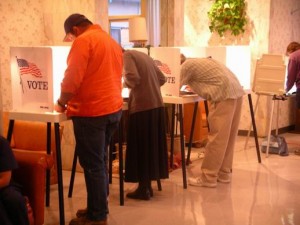
In a striking contrast to the actions of Congress when it comes to transportation funding, a handful of local jurisdictions went to the ballot this week and approved new taxes for transportation investments.
This week in Washington, while debating a new multi-year transportation bill, the leadership in the House of Representatives blocked the mere mention of raising or indexing the country’s gas tax to pay for a transportation bill currently drawing 30 percent of its price tag from every source under the sun — except for the actual users of the transportation system. No proposed amendments to the House transportation bill that dealt with raising the gas tax were cleared to even receive a debate or vote on the House floor, with House leadership refusing to allow our elected leaders to hold an adult discussion about raising new sustainable revenues for transportation.
Meanwhile, in local communities across the country, even in this off-year election, a number of communities went to the ballot and approved new increases in fees or taxes to pay for numerous ambitious local transportation investments. In at least a few candidate races, transportation became a defining issue in elections between candidates.
One of the most notable victories for new transportation funding occurred in Seattle, where voters approved the extension of a property tax levy to fund the ambitious Move Seattle plan, kickstarting work on seven new Rapid Ride bus rapid transit (BRT) corridors, three new light rail access points, 150 miles of new sidewalks, at least 16 bridge seismic retrofits, and the repaving of 180 miles of arterial streets. We profiled Seattle’s story just last week and shared more about their vision for investing in transportation and transit specifically to ensure their continued economic prosperity:
Seattle making smart decisions today to continue their city’s renaissance tomorrow
Downtown Seattle has become the hot place in the region for companies to locate as employment and growth has accelerated to new highs over the last decade, but limited space downtown could stymie job growth and economic potential if Seattle doesn’t think differently about transportation. READ MORE.
Immediately north of Seattle in Snohomish County, a 0.3% sales tax was approved at the ballot to fund increased bus service, including new routes and more express buses connecting major job centers like Boeing’s Paine Field.
Earlier this spring Utah became the third state in 2015 to pass a comprehensive transportation funding bill, raising the state’s gas tax and tying it to inflation. Utah raised revenues to invest in a variety of transportation modes and also provided individual counties with the ability to go to the ballot to levy voter-approved sales taxes to fund critical local transportation priorities.
Those local votes in Utah counties happened this week, and of the 17 counties that decided to put the 0.25% sales tax increase on the ballot — including the six counties in the Salt Lake City metro and region’s public transit service area — ten approved the measures with at least one still too close to call in Salt Lake County. In the counties served by the Utah Transit Agency, 40 percent of the new revenues will go directly to UTA transit service.
Maine approved an $85 million transportation bond that will provide $68 million for highway and bridge construction and repair, $17 million for ports, rail, freight, aviation, and a share for biking and walking trails.
Along with the handful of Utah counties that rejected their sales tax measures, there was one notable defeat in Salem, Oregon, where a 0.21% payroll tax was rejected. The measure would have expanded bus service, including new evening and weekend service.
Transportation also became an issue in a handful of elections this year.
In Virginia, the state DOT is trying to make the best use of limited capacity on a busy interstate running into Washington, DC by converting a congested section of I-66 from HOV-only to HOT lanes during peak commuting hours. Hal Parrish, a candidate for a state senate seat who campaigned heavily on stopping this plan in its tracks, lost his race in the 29th Virginia Senate district.
The election happened back in August, but in Phoenix, Mayor Greg Stanton was reelected after making the primary focus of his campaign an ambitious plan to invest in transportation with new tax revenues and expand the region’s growing light rail system. As the Arizona Republic wrote, “Phoenix Mayor Greg Stanton won re-election in a landslide Tuesday [August 26th], vowing to continue his work to reshape the city through light-rail expansion and redevelopment projects in the once-sleepy urban core.”
Once again, the overall trend continues.
Voters support raising new revenue to invest in transportation, especially when the plan and the projects are clear and transparent. Whether the support from local voters or the state representatives winning re-election after supporting tax increases to invest in transportation over the last few years, Congress would do well to pay attention to this lesson.




